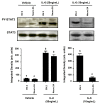Inhibition of interleukin-6 trans-signaling in the brain facilitates recovery from lipopolysaccharide-induced sickness behavior
- PMID: 21595956
- PMCID: PMC3113341
- DOI: 10.1186/1742-2094-8-54
Inhibition of interleukin-6 trans-signaling in the brain facilitates recovery from lipopolysaccharide-induced sickness behavior
Abstract
Background: Interleukin (IL)-6 is produced in the brain during peripheral infection and plays an important but poorly understood role in sickness behavior. Therefore, this study investigated the capacity of soluble gp130 (sgp130), a natural inhibitor of the IL-6 trans-signaling pathway to regulate IL-6 production in microglia and neurons in vitro and its effects on lipopolysaccharide (LPS)-induced sickness behavior in vivo.
Methods: A murine microglia (BV.2) and neuronal cell line (Neuro.2A) were used to study the effects of stimulating and inhibiting the IL-6 signaling pathway in vitro. In vivo, adult (3-6 mo) BALB/c mice received an intracerebroventricular (ICV) injection of sgp130 followed by an intraperitoneal (i.p.) injection of LPS, and sickness behavior and markers of neuroinflammation were measured.
Results: Soluble gp130 attenuated IL-6- and LPS-stimulated IL-6 receptor (IL-6R) activation along with IL-6 protein release in both microglial (BV.2) and neuronal (Neuro.2A) cell types in vitro. Moreover, in vivo experiments showed that sgp130 facilitated recovery from LPS-induced sickness, and this sgp130-associated recovery was paralleled by reduced IL-6 receptor signaling, mRNA, and protein levels of IL-6 in the hippocampus.
Conclusions: Taken together, the results show that sgp130 may exert an anti-inflammatory effect on microglia and neurons by inhibiting IL-6 binding. These data indicate that sgp130 inhibits the LPS-induced IL-6 trans-signal and show IL-6 and its receptor are involved in maintaining sickness behavior.
Figures






References
-
- Maier SF, Goehler LE, Fleshner M, Watkins LR. The role of the vagus nerve in cytokine-to-brain communication. Neuroimmunomodulation. 1998;840:289–300. - PubMed
Publication types
MeSH terms
Substances
Grants and funding
LinkOut - more resources
Full Text Sources
Other Literature Sources
Research Materials

